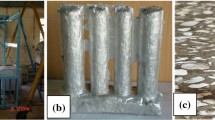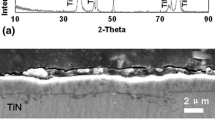Abstract
The wear of as-cast eutectic Al–Si was studied using pin-on-disk tribotests in two different environments, air and dry argon. The counterface in all tests was yttria-stabilized zirconia. It was found that wear of the Al–Si was reduced by about 60% by the removal of oxygen from the test environment. The zirconia counterfaces showed measurable wear after tests performed in air, while there was very little wear of the zirconia for tests conducted under argon. The near-surface regions of the Al–Si pins were examined using a transmission electron microscope (TEM), using specimens produced by focussed ion beam milling. The specimens that had been worn in air were characterized by a near-surface mechanically mixed layer containing a considerable amount of both aluminum oxide and zirconium oxide—the aluminum oxide particles had evidently acted as abrasive agents to remove material from the zirconia counterface. In contrast, TEM analysis of the Al–Si tested in argon showed little zirconium oxide in the near-surface regions.














Similar content being viewed by others
References
Shivanath R, Sengupta PK, Eyre TS (1977) Wear of aluminium-silicon alloys. Wear of materials 1977. ASME, New York
Sarkar AD, Clarke J (1980) Wear 61:157
Rigney DA (2000) Wear 245:1
Li XY, Tandon KN (2000) Wear 245:148
Li J, Elmadagli M, Gertsman VY, Lo J, Alpas AT (2006) Mater Sci Eng A421:317
Akarca SS, Altenhof WJ, Alpas AT (2007) Tribol Int 40:735
Elmadagli M, Alpas AT (2006) Wear 261:367
Razavizadeh K, Eyre TS (1982) Wear 79:325
Quinn TFJ (1983) Tribol Int 16:257
Basavakumar KG, Mukunda PG, Chakraborty M (2007) J Mater Sci 42:7882. doi:https://doi.org/10.1007/s10853-007-1633-7
Chen M, Perry T, Alpas AT (2007) Wear 263:552
Chen M, Alpas AT (2008) Wear 265:186
Chen M, Meng-Burany X, Perry TA, Alpas AT (2008) Acta Mater 56:5605
Xu CL, Yang YF, Wang HY, Jiang QC (2007) J Mater Sci 42:6331. doi:https://doi.org/10.1007/s10853-006-1189-y
Dwivedi DK (2006) Mater Des 27:610
Basavakumar KG, Mukunda PG, Chakraborty M (2007) J Mater Proc Tech 186:236
Kennedy FE, George M, Baker I, Johnson BJ, Chang N (1996) Influence of composition and environment on wear of NiAl and Ni–Fe–Al. In: Proceedings of the international tribology conference, Yokohama 1995. Japanese Society of Tribologists I, pp 337–342
Munroe PR, Baker I, George M, Kennedy FE (2002) Mater Sci Eng A325:1
Giannuzzi LA, Stevie FA (1999) Micron 30:97
Johnson BJ, Kennedy FE, Baker I (1996) Wear 192:241
Hutchings IM (1992) Tribology, friction and wear of engineering materials. CRC Press, Boca Raton, FL
Bhushan B, Gupta BK (1991) Handbook of tribology. McGraw-Hill, New York
Murray SF (1997) Properties of advanced ceramics. Tribology data handbook. CRC Press, Boca Raton, FL
Kennedy FE (2001) In: Bhushan B (ed) CRC handbook of modern tribology. CRC Press, Boca Raton, FL, p 235
Acknowledgements
This research was supported by the U.S. National Science Foundation (NSF) grant CMMI-0651642. The views and conclusions contained herein are those of the authors and should not be interpreted as necessarily representing official policies, either expressed or implied, of the NSF or the U.S. Government. We would like to acknowledge the help of Dr. Charles Daghlian and Michael Gwaze.
Author information
Authors and Affiliations
Corresponding author
Appendix: Calculation of contact area and contact temperature
Appendix: Calculation of contact area and contact temperature
Contact of stationary Al–Si pin with moving Zirconia disk
Operating conditions:
Normal load w = 23 N | Sliding velocity V = 1 m/s |
Friction coefficient (measured) μ = 0.4 | Pin radius R pin = 4.75 mm |
Material properties (* measured, remainder from [22])
Al–Si (material 2) | Zirconia (material 1) | |
|---|---|---|
H Hardness (GPa) | 0.462* | 14 |
E Modulus of Elasticity (GPa) | 70* | 290 |
ρ Density (kg/m3) | 2654* | 6100 |
ν Poisson’s ratio | 0.33 | 0.24 |
K Thermal Conductivity (W/m K) | 140 | 1.8 |
C Specific heat (Nm/kg K) | 630 |
Contact Geometry (assuming Hertzian contact [21])
Using 2 and 3 and operating parameters in 1 find the contact radius
Contact Temperature rise (following methodology of [24])
Assume stationary Al–Si pin (material 2) and moving flat Zirconia disk (material 2)
and
Using 5, 6, 7, and the material properties (above) in 5, find the peak contact temperature rise (above room temperature) ΔT max = 200 °C.
This is the temperature rise due to frictional heating for the Hertzian contact. Given that the tests were conducted at room temperature (about 25 °C), the surface temperature at the center of the Hertzian contact area was thus at least T max = 225 °C.
It should be noted that the temperature analysis outlined above gives a relatively conservative estimate of the contact temperature at the interface between the hemispherically shaped Al–Si pin and the flat zirconia disk, since a single Hertzian (elastic) contact was assumed. The contacting material within the Hertzian contact region on the stationary Al–Si pin would remain at an elevated temperature for a substantial period of time, allowing plenty of time for oxidation to occur, even at 225 °C [8]. In the actual contact, it is probable that at any instant the real area of contact within the Hertzian region consisted of a finite number of concentrated asperity-level contacts. The peak contact temperature rise could be considerably higher at localized asperity contacts, but these would be of shorter duration (flash temperature rise).
Rights and permissions
About this article
Cite this article
Baker, I., Sun, Y., Kennedy, F.E. et al. Dry sliding wear of eutectic Al–Si. J Mater Sci 45, 969–978 (2010). https://doi.org/10.1007/s10853-009-4027-1
Received:
Accepted:
Published:
Issue Date:
DOI: https://doi.org/10.1007/s10853-009-4027-1




